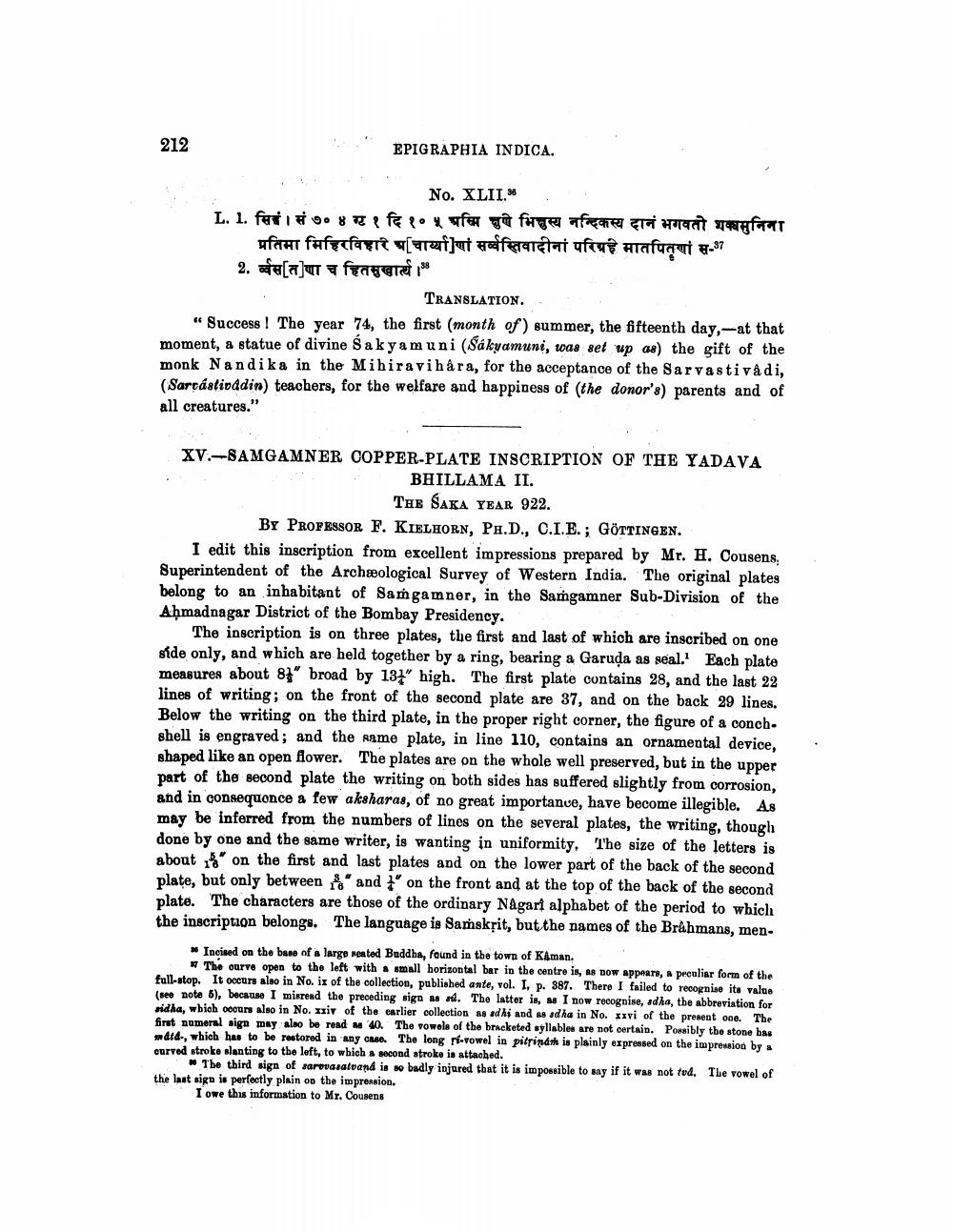________________
212
EPIGRAPHIA INDICA.
No. XLII. L. 1. सिहं । सं ७०४ र १ दि १०५ अस्मि पुणे भिक्षुस्य नन्दिकस्य दानं भगवतो शक्यमुनिना
प्रतिमा मिहिरविहार प[चार्याणां सर्वस्तिवादीनां परिग्रह मातपितृणां स-37 2. f[a] facere
TRANSLATION. "Success! The year 74, the first (month of) summer, the fifteenth day,--at that moment, a statue of divine Sakyamuni(Sákyamuni, was set up as) the gift of the monk Nandika in the Mihiravih à ra, for the acceptance of the Sarvasti vadi, (Sarcástivddin) teachers, for the welfare and happiness of the donor's) parents and of all creatures."
XV.-AMGAMNER COPPER-PLATE INSCRIPTION OF THE YADAVA
BHILLAMA II.
THE SAKA YEAR 922. BY PROFESSOR F. KIELHORN, PH.D., C.I.E.; GÖTTINGEN. I edit this inscription from excellent impressions prepared by Mr. H. Cousens, Superintendent of the Archeological Survey of Western India. The original plates belong to an inhabitant of Samgamner, in the Samgamner Sub-Division of the Ahmadnagar District of the Bombay Presidency.
The inscription is on three plates, the first and last of which are inscribed on one side only, and which are held together by a ring, bearing a Garuda as seal. Each plate measures about 83" broad by 13%" high. The first plate contains 28, and the last 22 lines of writing; on the front of the second plate are 37, and on the back 29 lines. Below the writing on the third plate, in the proper right corner, the figure of a conch. shell is engraved; and the same plate, in line 110, contains an ornamental device, shaped like an open flower. The plates are on the whole well preserved, but in the upper part of the second plate the writing on both sides has suffered slightly from corrosion, and in consequonce a few aksharas, of no great importance, have become illegible. As may be inferred from the numbers of lines on the several plates, the writing, though done by one and the same writer, is wanting in uniformity. The size of the letters is about 16' on the first and last plates and on the lower part of the back of the second plate, but only between s' and ' on the front and at the top of the back of the second plate. The characters are those of the ordinary Nagari alphabet of the period to which the inscription belongs. The language is Samskrit, but the names of the Brahmans, men
Incised on the base of a large seated Baddha, found in the town of Kaman.
The curve open to the left with a small horizontal bar in the centre is, as now appears, a peculiar form of the full-stop. It occurs also in No. ix of the collection, published ante, vol. I, p. 387. There I failed to recognise its value (see note 5), because I misread the preceding sign as al. The latter is, as I now recognise, sdha, the abbreviation for ridha, which occurs also in No. xxiv of the earlier collection as adhi and as ad ha in No. xxvi of the present one. The first numeral sign may also be read a 40. The towels of the bracketed syllables are not certain. Possibly the stone has matd., which has to be restored in any case. The long ri-vowel in pitrinath is plainly expressed on the impression by a curved stroke slanting to the left, to which a second stroke is attached.
The third sign of sarovasatvand is so badly injured that it is impossible to say if it was not tud. The vowel of the last sign is perfectly plain on the impression.
I owe this information to Mr. Cousens




